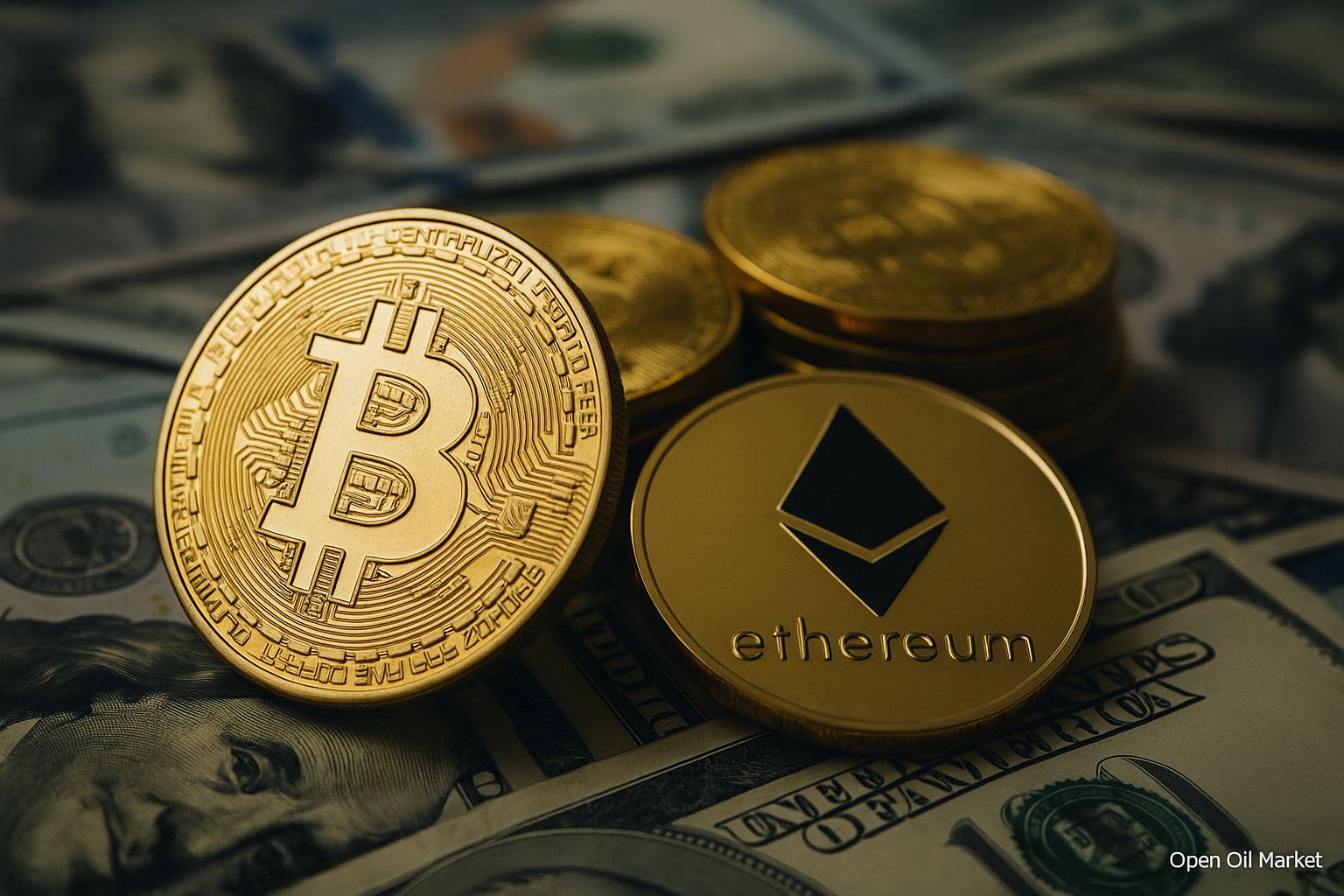Crypto Market News Overview as of November 21, 2025: Bitcoin Consolidates After Correction, Ethereum Prepares for Update, Altcoins Recover, Institutional Investors Expand Presence, and Market Stabilizes.
As of the morning of November 21, 2025, the cryptocurrency market is attempting to stabilize after a sharp decline in the first half of the month. Bitcoin is trading around $90,000, having lost nearly 30% from its historical peak in October (approximately $126,000). Over the past month, the total cryptocurrency market capitalization has decreased by about $1.2 trillion; however, in recent days, the decline has halted. Major altcoins are also holding key levels: Ethereum has stabilized around $3,000 amid expectations of an important network update, while Bitcoin's dominance index has dropped below 60%, reflecting the relative resilience of several altcoins. Investors and analysts are currently evaluating whether the current correction is temporary before new growth or if the market is poised for a prolonged consolidation phase.
Bitcoin After Significant Correction
At the beginning of October, flagship Bitcoin (BTC) reached a new peak of about $126,000 but quickly transitioned into a correction phase. Last week, the price of Bitcoin fell to approximately $88,000—its lowest level in the past six months—representing a decline of over a quarter from its historical high. As of now, BTC has recovered to the $90,000–$92,000 range and is showing signs of stabilization. Bitcoin's market capitalization stands at around $1.8 trillion, maintaining about 58-60% of the overall cryptocurrency market capitalization. Experts note that the drivers behind the recent decline include profit-taking by investors after a prolonged rally and a tightening of rhetoric from the US Federal Reserve, suggesting continued high rates to curb inflation. Nevertheless, the fundamental factors for Bitcoin remain positive: institutional adoption of the asset continues, and the upcoming halving in 2024 strengthens the expectations for long-term growth. Currently, Bitcoin is consolidating around the psychologically significant level of $100,000 (acting as resistance); surpassing this level could return the market to a bullish trend, while failing to hold above $90,000 may signal prolonged consolidation.
Ethereum Prepares for Major Update
The second-largest crypto asset, Ethereum (ETH), has also experienced significant volatility. After rising close to $5,000 in October, Ether retraced approximately 35% and is currently trading around $3,000. Despite the correction, Ethereum retains a ~12% market share as the leading platform for decentralized applications and DeFi. Investors are optimistic about the upcoming network update, code-named Fusaka, scheduled for early December 2025. This hard fork aims to enhance Ethereum's scalability and implement new technical solutions (in particular, technologies to accelerate Layer 2 operations), which should improve network efficiency and attract even more users. Discussions around the update have already led to increased activity within the developer community and boosted confidence in the long-term prospects for ETH. In recent weeks, Ethereum has shown relative strength due to expectations surrounding the launch of new institutional products—spot ETFs for Ether were approved in the US last fall, making access to ETH easier for large investors. Analysts believe that the successful execution of the December update could provide Ether with additional momentum for regaining its position, especially if market sentiment improves.
Altcoins Exploring Growth Opportunities
The broad altcoin market is attempting to transition towards recovery following the October decline. During the correction, many popular altcoins lost 20-30% of their value; however, recent sessions have brought signs of revival. Bitcoin's dominance has decreased from over 60% to approximately 58%, indicating relatively better dynamics for some alternative coins. Some high-cap tokens are demonstrating resilience: for example, Ripple (XRP), which soared to a multi-year high of around $3.00 after Ripple's legal victory over the SEC last summer, has corrected to $2.1–$2.2, but remains above $2, retaining a significant portion of its gains. Binance Coin (BNB) recently hit an all-time high (reaching approximately $1,375 during the peak October rally); it is now trading around $900 after correction, still significantly above its levels at the beginning of the year. The ongoing interest in BNB is attributed to the broad Binance ecosystem and regular coin burns, which decrease supply. Other market leaders, such as Solana (SOL), are holding around $140 after peaking at around $200, bolstered by news regarding potential ETF launches and increased activity within its blockchain ecosystem. Smart contract platform tokens like Cardano (ADA) and TRON (TRX) have dropped more than 40% from annual highs but remain in the top ten. The meme cryptocurrency Dogecoin (DOGE), favored by many investors, remains around $0.16–$0.17, showing that even 'joke coins' with active communities can weather periods of volatility without losing interest. New promising projects are also worth noting: several relatively new cryptocurrencies are positioned just behind the market leaders. For instance, the token of the decentralized exchange Hyperliquid (HYPE) surged into the list of top cryptocurrencies by capitalization in 2025 due to its unique technological offering, and its value is holding at a high level amid rumors of a new ETF launch. Similarly, altcoins with their own growth catalysts—such as Uniswap (UNI)—are drawing increased attention as DeFi tools develop. Overall, while a broad "altseason" is not yet observed, individual digital assets are demonstrating relative strength even amid a general market correction.
New Crypto ETFs and Institutional Interest
One of the key themes at the end of 2025 has been the expansion of instruments for institutional investors in the cryptocurrency market. In the US, following the successful launch of spot Bitcoin ETFs and Ether ETFs in previous months, regulators have approved the listing of the first multi-asset cryptocurrency ETF. The fund from Bitwise, which received preliminary approval from the SEC in November, tracks an index of the top 10 digital assets, including Bitcoin, Ethereum, Ripple (XRP), Solana (SOL), and other leading currencies. This decision is seen as an important signal: the market perceives it as a step towards further integration of cryptocurrencies into the traditional financial system. Notably, amid the ETF news, capital flows are being redistributed: according to industry reports, in November, there was a net outflow of approximately $1.6 billion from Bitcoin funds—likely due to profit-taking after the previous rally—while Solana-related funds attracted about $26 million in new investments. This dynamic indicates some investors' interest in promising altcoins and asset diversification. Overall, institutional players continue to enter the cryptocurrency space: media reports indicate that several large university endowments and pension programs have increased their investments in crypto funds. Notably, Harvard's endowment fund invested approximately $440 million in BlackRock's Bitcoin trust—viewed as a sign of long-term confidence in BTC from conservative institutional investors. The regulatory environment for the industry is gradually clarifying as well: new laws aimed at providing clearer regulation of cryptocurrencies (including initiatives for classifying digital assets and protecting investors) have come into effect in the US. Experts expect that the further introduction of exchange-traded products on various crypto assets (with XRP, Ethereum Layer-2 tokens, and others in development) will depend on regulators' readiness to recognize the utilitarian value of these projects. The expansion of the crypto ETF lineup and the influx of institutional funds are strengthening the market's fundamentals, albeit adding correlation with traditional finance.
Market Sentiment and Volatility
The period of rapid growth, followed by a sharp correction, has impacted trader sentiments. The cryptocurrency "fear and greed" index, which during the peak of the October rally exceeded 70 points ("greed"), fell into the "fear" zone in November, hovering around 30-40 points. This indicates a dominance of cautious sentiments: many market participants reduced their risk exposure amid declining prices. The scale of volatility is corroborated by liquidation statistics: according to exchanges, during the days of the sharpest decline (October 10-11), the total volume of forcibly closed positions exceeded $10–15 billion, with many leveraged traders being wiped out from the market. Last week, when Bitcoin temporarily fell below $100,000, the daily liquidation volume also exceeded $1 billion, particularly in long positions, exacerbating the downward momentum. However, after reaching a local bottom, signs of panic started to wane. Volatility remains elevated but has slightly decreased from the peak values of October. Currently, the sentiment index has risen from the deep "fear zone" closer to neutral values, reflecting a gradual return of confidence as prices stabilize. Analysts caution that sharp fluctuations are still possible in the market—especially in the case of unexpected macroeconomic news or regulations. Nevertheless, the gradual cooling of euphoria and the passing of the "capitulation" stage among speculators could create a foundation for more balanced growth ahead. Recent years' experiences show that following periods of extreme volatility, the crypto market often enters a phase of relative calm, allowing investors to regroup and assess new entry points.
Forecasts and Expectations
Despite the recent correction, many experts maintain a moderately optimistic outlook on the future development of the cryptocurrency market. Analysts at Standard Chartered Bank note that the current ~30% drop in Bitcoin fits within the scope of a typical correction in a bull market and is likely nearing completion. They estimate that the current decline is already the third comparable drop since the introduction of the first spot ETFs, and each time after such pullbacks, the market found a new bottom and resumed its growth. The bank still considers the possibility of a year-end rally scenario: the base forecast anticipates Bitcoin returning to an upward trend in December if macroeconomic conditions remain stable. Some market participants also point to on-chain indicators suggesting a "breathing out" of sellers: short-term holders have already realized losses, and trading volumes on exchanges have decreased, which is characteristic of local bottom phases. Optimists believe that in 2026, as monetary policy loosens and interest in cryptocurrencies grows in emerging markets, Bitcoin could reach new heights—targets of $180,000–$200,000 are mentioned. More conservative forecasts expect a gradual recovery: for instance, several Wall Street analysts believe that the $120,000 mark will again become attainable in the second half of 2026, provided there are no new crises. Regarding altcoins, their prospects largely depend on Bitcoin's behavior: for a full-scale "altseason" to begin, BTC needs to stabilize near its record values and attract new capital inflows to the market. So far, forecasts indicate that quality projects with real applications—such as smart contract platforms and key infrastructure tokens—will recover faster and attract more investors compared to speculative coins without fundamental value. Amid the remaining uncertainty, market participants are advised to exercise caution; however, they note that each major downturn previously provided long-term investors with opportunities to enter the market at more attractive prices.
Top 10 Most Popular Cryptocurrencies
As of the morning of November 21, 2025, the 10 most popular cryptocurrencies by market capitalization include the following digital assets:
- Bitcoin (BTC) – the first and largest cryptocurrency. BTC is trading around $91,000 after a recent correction, with a market capitalization of approximately $1.8 trillion (around 59% of the entire market). Bitcoin maintains its status as "digital gold" and the foundation of the crypto market, embodying the trust of most institutional investors.
- Ethereum (ETH) – the leading altcoin and platform for smart contracts. The price of ETH is around $3,000, which is below recent local peaks, but Ether remains the second-largest cryptocurrency by market value at approximately $360 billion (~12% of the market). With a vast ecosystem of decentralized applications, Ethereum continues to captivate investors and developers.
- Tether (USDT) – the largest stablecoin pegged to the US dollar 1:1. USDT is actively used for trading operations and hedging on crypto exchanges, with a market capitalization estimated at around $150 billion. The coin consistently holds a price of $1.00 (≈₽80) per token due to its reserve backing, remaining a crucial element of liquidity in the market.
- Binance Coin (BNB) – the token of the largest exchange Binance and the native coin of the BNB Chain blockchain. The price of BNB has corrected to approximately $900 (with a market capitalization of around $140 billion) after its record highs in October, but the token remains among the leaders. BNB is in demand due to its wide applications: paying fees on the exchange, participating in token sales, and utilizing it in DeFi projects on the BNB Chain.
- Ripple (XRP) – the token of the Ripple payment network for cross-border settlements. XRP trades around $2.13, with a market capitalization of about $110 billion. In the summer of 2025, XRP received legal confirmation of its status (not being a security in the US), leading to a restoration of trust and its return to the top ranks in cryptocurrency ratings.
- Solana (SOL) – a high-performance blockchain platform for decentralized applications. SOL is valued at approximately $140 per coin (with a market capitalization of around $65 billion), showing recovery after its decline. Solana attracts investors with its high transaction speeds and recent news about a potential ETF launch based on it, highlighting growing institutional interest.
- USD Coin (USDC) – the second-largest stablecoin, issued by Circle and backed by dollar reserves. USDC trades stably at $1.00, with a market capitalization of around $60 billion. Thanks to reserve transparency and partnerships with traditional financial institutions, USDC is widely used in corporate settlements and the DeFi market, remaining a reliable "safe haven" for traders.
- TRON (TRX) – a blockchain platform for smart contracts and entertainment dApps, popular in Asia. TRX is priced at around $0.28 (market cap ~ $27 billion). Tron has secured a position in the top 10 largely due to active use of its network for the issuance of stablecoins (a significant portion of USDT is in circulation on the Tron blockchain), alongside maintaining high network throughput and low fees.
- Dogecoin (DOGE) – the most well-known "meme cryptocurrency," created as a joke and becoming iconic. DOGE is trading around $0.16 (market cap ~ $24 billion). Despite its playful origin, Dogecoin has a dedicated army of supporters and periodically gains growth momentum due to endorsements from well-known entrepreneurs. DOGE remains highly volatile, but its presence in the top 10 underscores the unique community effect on the value of crypto assets.
- Cardano (ADA) – a blockchain platform evolving based on a scientific approach and phased upgrades. ADA is valued at approximately $0.47 after correction (market cap around $16 billion). Earlier in 2025, Cardano attracted attention with expectations of ETF launches and network updates; however, the current decline has brought the price back to mid-year levels. Nevertheless, the project boasts an active community and plans for scaling, which supports its position among the largest cryptocurrencies.
Cryptocurrency Market as of November 21, 2025
- Key cryptocurrency rates: Bitcoin (BTC) ~$91,300; Ethereum (ETH) ~$3,010; XRP ~$2.13; BNB ~$900; Solana (SOL) ~$141; Tether (USDT) $1.00.
- Market indicators: the total cryptocurrency market capitalization is around $3.2 trillion; Bitcoin's share is ~58%; the fear and greed index stands at 45 (neutral/moderate fear mode).
- Top gainers over the day: Zcash (ZEC) +11% (increased interest in privacy coins amid regulatory discussions); Polygon (MATIC) +4% (recovery after network updates).
- Top losers over the day: Filecoin (FIL) -6% (correction after a short-term price spike); Conflux (CFX) -5% (profit-taking amid a lack of new drivers).
- Analysis: The market is demonstrating mixed dynamics—leading coins are holding their positions, while lesser-cap altcoins are showing divergent fluctuations. The moderate increase in sentiment index points to a waning of panic sentiments; however, seller activity remains in certain tokens without strong news triggers. Investors are closely monitoring Bitcoin in the $90,000–$100,000 range as a barometer for the future direction of the market: its confident rise could lift the rest of the crypto market, while prolonged consolidation of BTC might signify continued selective movement in altcoins based on their fundamental news.




